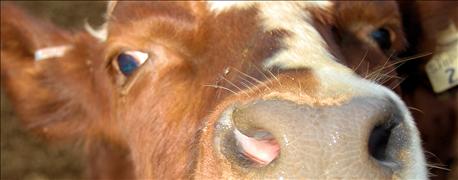
Everyone in the milk business knows dairy farmers are in the market-squeeze mode. Bruce Dehm of Dehm Associates, Geneseo, N.Y., has a good grasp on just how tight that squeeze is. He tracks financial performance on a number of dairy farms.
Most farms are borrowing their way through the current milk cycle low, according to Dehm. “For the first nine months of 2016, only 23% of our clients were at a positive cash position after paying for expenses, family draws and short-term debt service. Of these, half have non-dairy income averaging 8% of their milk sales.

MOO-RE MONEY PLEASE! USDA and states open new ways to help milk producers survive this milk market trough.
“The other 77% are using debt creatively to keep cash in the checking account. Some 23% are increasing operating lines of credit and accounts payable.
“Some 76% have borrowed with intermediate or long-term loans to refinance bills and/or restructure/consolidate existing loans. Others have borrowed more than the capital purchases (new barns, etc.) that they’ve invested in this year to cover cash flow shortages.”
Traits of the positive 23%
Those with a positive cash position keep an excellent set of books, notes Dehm. Their principal and interest payments range from 9% to 14% of milk sales.
Their cows produce an average of 5.8 pounds of butterfat and protein per cow per day. Purchased feed costs average $5.55 per hundred pounds of purchased produce for milking, dry and young stock animals. And this segment grows half of their own grain.
“So far, lenders have been willing to help their dairy farm customers suffer through a second year of low milk prices,” acknowledges Dehm. But he warns: “There are indications that the free flow of new debt capital may be hard to come by as time goes by.”
Challenges and opportunities
New York’s Milk Marketing Advisory Council was convened in late November to address key market and trade barrier issues — and opportunities. Afterward, Council Chairman Andrew Novakovic agreed that the dairy industry faced “daunting challenges but also terrific opportunities.”
The MMAC, composed of more than 24 members from dairy manufacturing and processing sectors and cooperatives plus consumer and retail reps, discussed the current milk market situation, rising production, and trade agreement policies, in particular with Canada. This came on the heels of Gov. Andrew Coumo’s letter to the prime minister of Canada, Justin Trudeau, expressing opposition to proposed regulations that would create a barrier for New York’s dairy farmers exporting ultra-filtered milk to Canada. The governor called on the Canadian government to develop a national agreement that would mutually benefit trade across borders.
One opportunity that will help at least some dairy producers and processors is the newly expanded NYS Grown & Certified program. Launched in August, the food-labeling program assures consumers they’re buying local food produced via good agricultural practices by producers enrolled in a certified environmental management program.
Fed help for graziers
Also in November, USDA rolled out a new grasslands initiative version of the Conservation Reserve Program targeting smaller-scale beef, dairy sheep, goat and llama operations — less than 100 head grazing and enrollment of up to 200 acres per farm. It’s particularly well fitted for dairies in Pennsylvania and the Northeast, according to USDA Deputy Undersecretary Alexis Taylor.
Participating dairy and beef farms would receive annual payments for up to 75% of the grazing value or up to 55% on cover crops, fencing and rotational grazing cost shares, and still be able to graze the land. CRP Grasslands requires a 10- to 15-year contract, protecting the land from conversion to row crops and urbanization.
The current sign-up program ends this week. But you can sign up early for the next enrollment period. Contact your local Farm Service Agency office for details.
Learn more about CRP Grazing in this Q and A: Check out USDA's CRP Grasslands Initiative.
About the Author(s)
You May Also Like




